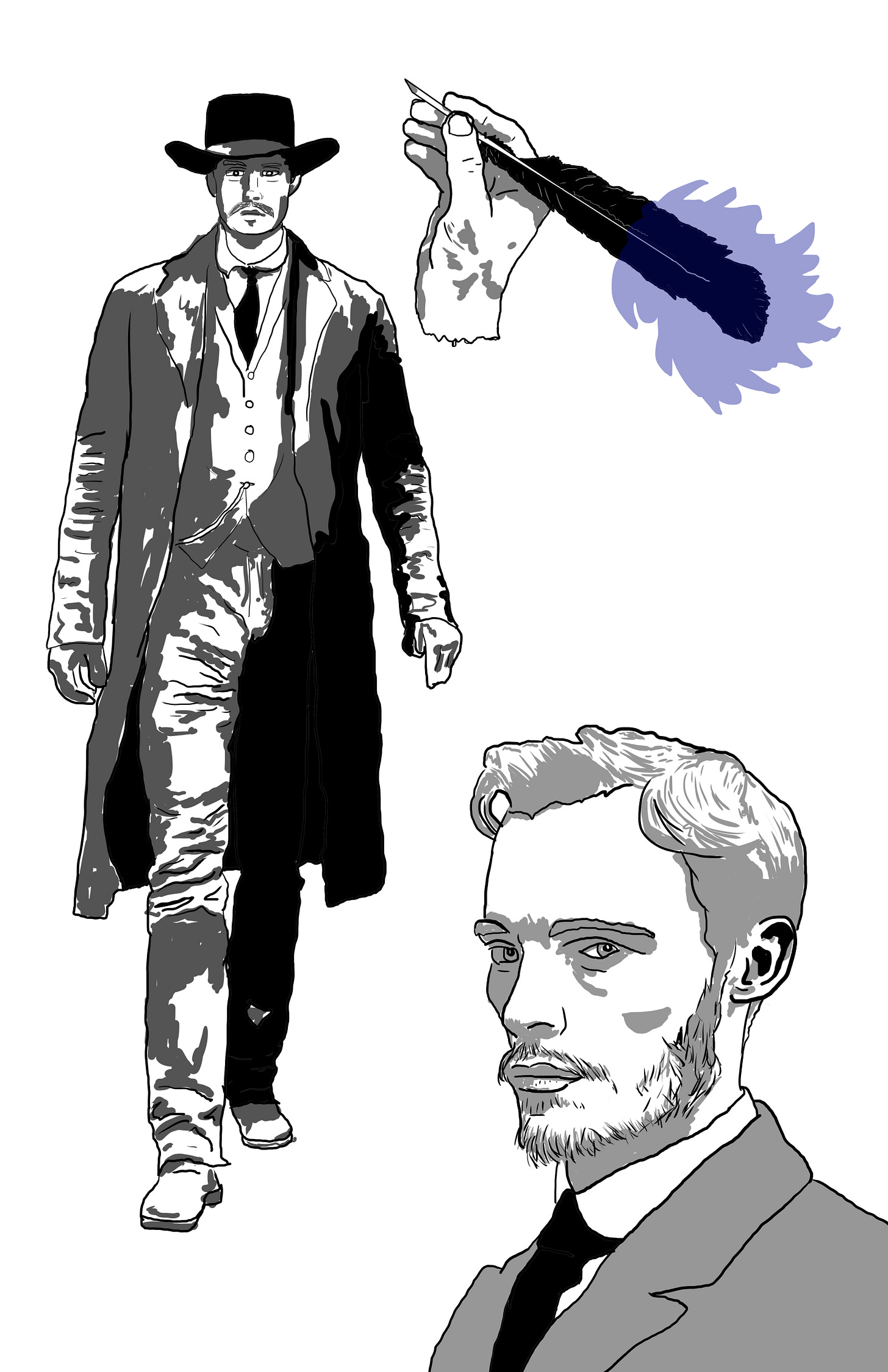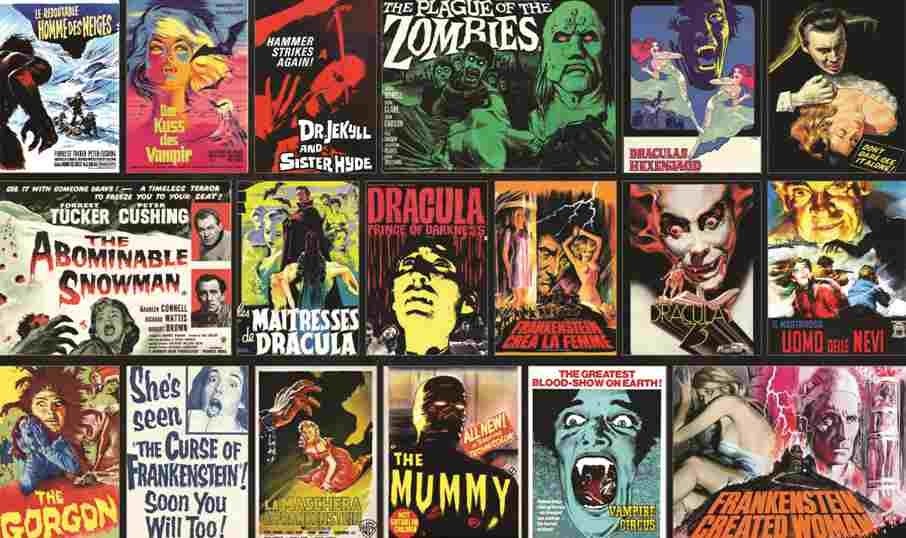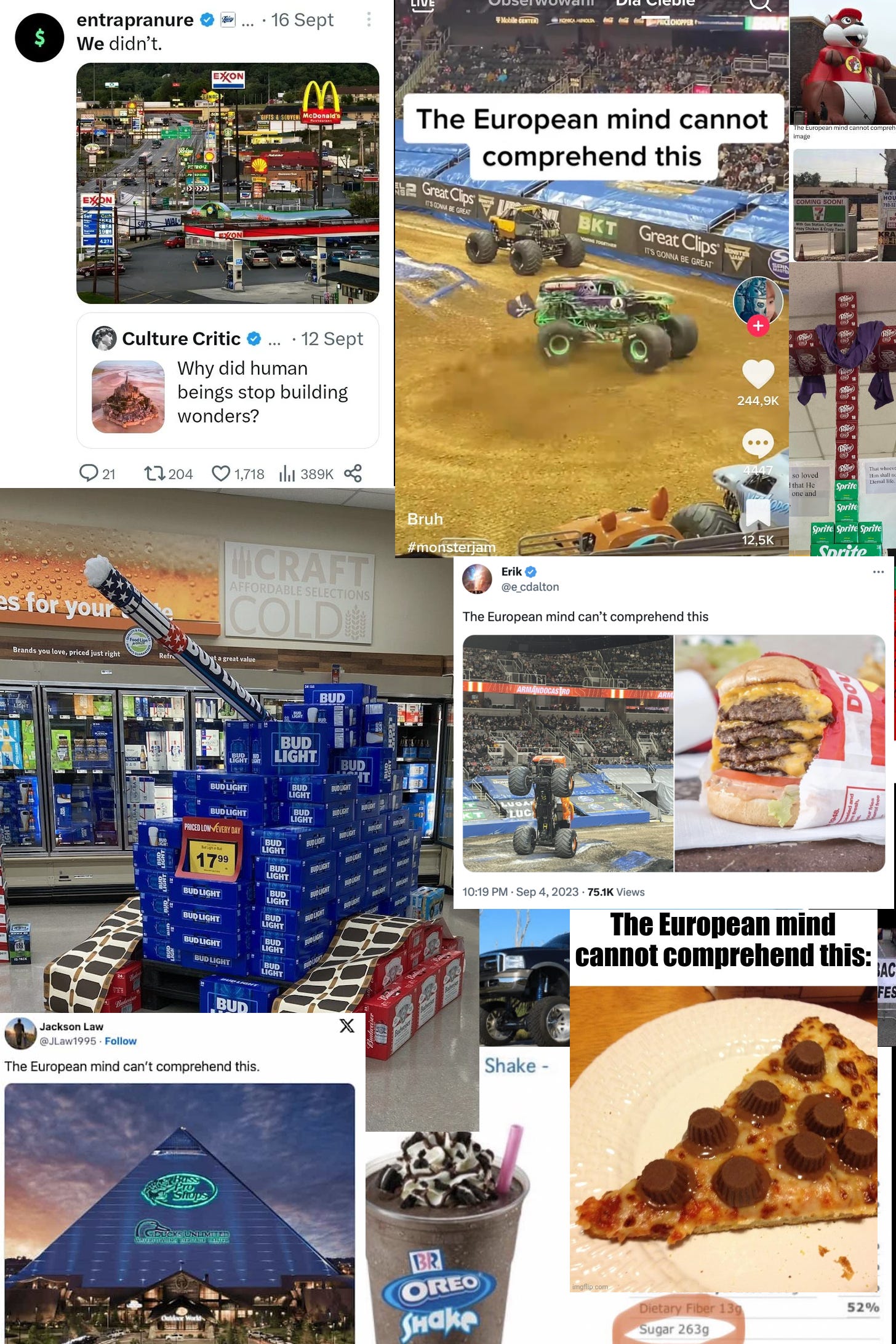Hello y’all–
Ben Bolling, here. Welcome to the first installment of our new ongoing series American Gothic: The Hand of Poe!
If you’re new around these parts, The Hand of Poe is the second volume in our American Gothic series. We published the first volume here on Substack as Southern Gothic (but we’re gently transitioning to the title American Gothic: Good Country People as we gear up for print distribution!). If you’re itching to catch up before we dive into the next chapter, you can access the entire New Futurists archive as a paid subscriber. But rest assured, Ezequiel and I have created The Hand of Poe to stand on its own for new readers.
And to all of our returning readers: hello, dear friends. Welcome to our second rodeo!
As we created the first volume of American Gothic semi-live for y’all on Substack from 2022-2024, our whole creative team was overwhelmed by the outpouring of feedback, questions, and support we received. Literally YESTERDAY, Ezequiel and I exchanged emails about how much we love our readers— no joke. And over the last few years, we came to realize that y’all like to read about the behind-the-scenes process almost as much as the comics themselves. So, to kick off The Hand of Poe, Ezequiel and I had a conversation about the project that we wanted to share with y’all.

Ben Bolling: So for new readers, Ezequiel Rubio and I co-created Southern Gothic/American Gothic in 2021-2022. Please go follow him on social media and all that business. This guy is one of the good ones. So tell me, Ezequiel, did you think we would continue this project after Southern Gothic? I confess: I did NOT! I thought that comic was a self-contained story with a beginning, middle, and end. But very early on in the process, I realized how much I enjoyed working with you. And I also started having all sorts of ideas for side plots that just didn’t fit into the central arc of the first volume.
Ezequiel Rubio: The truth is that since I wasn’t sure how Southern Gothic would end, I always kept the possibility of continuing the story in some way in mind. The fact that it ended up being with Poe makes perfect sense. Of all the secondary characters, for me, he was the one with the most potential for a possible spin-off, as an unlikely action hero.
Ben: Yeah, as we reached the conclusion of Southern Gothic, I kept thinking about side adventures for Tennessee and Truman because they really took on a life of their own as we worked on that story. But Poe was the stand-out for me, too. I think you and I both enjoyed working on the sequences featuring Poe. And given the gap in time between his “origin story” and the 1955 setting of the first volume, I couldn’t stop thinking about what he’d been up to during the missing 75 years or so! When we started appearing at conventions and I talked to people who absolutely LOVED Poe and wanted more of him, well, you have to give the people what they want, right?
So, what’s your experience with Poe? When did you first encounter his work?
Ezequiel: My first encounters with Poe were probably through some Hammer adaptation (like The Pit and the Pendulum, which I remember watching at a local theater!) and also The Simpsons’ Halloween specials! Later, when I was older, I read his stories. He’s definitely one of my favorite horror authors, and I’m planning to reread his tales (which I’ll do, thanks to the edition you so kindly gifted me!).
Ben: Oh yeah, when we finished Southern Gothic, I sent Ezequiel a Poe collection to let him know he couldn’t get rid of me that easily!
Wow. I hadn’t thought about Hammer Films in a hot minute! I think we got those on cable in the ‘90s in the U.S.? (Maybe one of our readers will fact check me on this claim!) I definitely remember watching some of those adaptations late at night when I was probably too young!
The trans-Atlantic reach of Poe fascinates me!
I have no idea when I first encountered Poe. I do remember reading “The Raven” and “The Cask of Amontillado" in middle school— like 7th and 8th grade, maybe? And I definitely remember checking a collection of short stories out of the public library one summer when I was in high school. I devoured it. And like you, I had probably encountered so many references via things like The Simpsons, so it was one of those moments where a thousand cultural references suddenly made sense. But get this: I can’t remember reading Poe in an academic setting any time after high school. Granted, my academic interests have always been in 20th-century literature, but it’s really wild when I think about just how many hours I’ve logged studying American literature and how little of that time included our boy Poe! So I have to say, I REALLY enjoyed doing research as we started developing Hand of Poe.
Ben: But in addition to switching our narrative focus to Poe, we’re also going to a completely different setting: the American West in the 1870s. What’s your experience with the Western genre? Do you know that meme template “The European mind cannot comprehend…” and it’s like a picture of an American eating a cheeseburger the size of their head or a pickup truck with 5 exhausts and 50 inch tires? I have to admit, I thought of that meme when I first pitched you on a Poe Western!
Ezequiel: What can I say about Westerns? Personally, it’s a genre I absolutely love, and it might just be what I enjoy drawing the most. I love illustrating those open spaces, the canyons, the mountains... and all of it tied to the unique aesthetics of the genre: the clothes, the saloons, the cowboys, the Sioux, the Apaches... I remember as a kid knowing the names of many tribes, and one of my mom’s friends used to call me "Blackfoot," which would annoy me because I preferred being Sioux (I thought "Blackfoot" sounded like I had dirty feet, haha). Later, I remember going to watch Dances with Wolves. I was pretty young, but I left the theater amazed. Even today, it remains one of my all-time favorite films. I think Westerns have a uniquely American mythology that fascinates many Europeans. After all, some of the best Western comics have been made in Europe (Blueberry, Undertaker, etc.).
Ben: I couldn’t agree more about how some of the most interesting Westerns are produced by European creators. I mean, c’mon: Sergio Leone and Sergio Corbucci!?! Also, I had forgotten that a lot of Western movies have been filmed in Spain. Of COURSE there’s interest in the genre across Europe! I love that you were also drawn to Indigenous characters. My dad’s family has Indigenous roots, so I went through a phase around 3rd or 4th grade when I was obsessed with learning the distinctions among the Plains tribes!
My dad is an avid Western fan and I remember watching classic films like True Grit, My Darling Clementine, and Butch Cassidy and the Sundance Kid with him from a very young age. There was also that Western renaissance in American cinema in the 1990’s— which was when I was a YOUTH and most plugged in to popular culture. I’m thinking Dances with Wolves, Unforgiven, Tombstone… those films. But, predictably, it was literature that really got me. Perennial shout out to my amazing high school English teachers Grace Bradshaw and Joan Short who directed me in an independent study where I read some books that left an indelible mark-- including Larry McMurtry’s Horseman, Pass By and The Last Picture Show. Let’s just say I fell down a rabbit hole after that. I remain a Larry McMurtry stan to this day. In college, I became much more interested in Indigenous narratives of the West and got into folks like Louise Erdrich and Sherman Alexie, while also still checking in with writers like Cormac McCarthy. As for Western comics, I read a handful of 1950s titles when researching my dissertation. Years later I read some contemporary comics about popular Western characters like Jonah Hex, the Lone Ranger, and that Django/Zorro crossover that Quentin Tarantino wrote. Oh and Pulp by Brubaker and Phillips who I know we both admire! So yeah, I love Westerns. But I never, EVER imagined writing in that genre!
Ben: As we shifted into American Gothic, you and I both had some ideas about stylistic changes, largely influenced by the shift in setting and genre, right?
My writing on the first volume was very much influenced by the EC Horror comics. But when I started thinking about Westerns, I realized those strict panel grids and dialogue-heavy scenes had to go. What worked in the 1950’s sci-fi/horror story of Southern Gothic just didn’t feely tonally or stylistically right for a Western. I mean, the Western LIVES in the wide shot! I feel like I immediately shifted to writing fewer panels or action beats per page and with MUCH less text. By virtue of having worked together for a while, I like to think I've gotten better at not overwriting for your art. Your character expressions and visual storytelling do a lot of the heavy lifting, so I’ve learned to pull back on that Claremont-esque tendency to tell the reader what they’re already seeing! Haha. (And that’s no dig at Chris Claremont. Everybody knows I’d lay down my life for the X-Men.)
Ezequiel: I completely agree with you. From the beginning, we talked about how the 9-panel page format we’d been using in much of Southern Gothic was too constraining for the story. I think this comic calls for something more flexible. For The Hand of Poe, I’ve been looking at Mignola, Darwyn Cooke, Alex Toth...their page designs. Of course, with all due humility, I’d like to aim for something similar.
Ben: I really appreciate the artists you reference because I’ve been thinking about many of them, as well. I watched that recent Mike Mignola documentary Drawing Monsters and it inspired me to study some Hellboy and Baltimore stories before I got started on the script for this project. It’s really interesting to me how we have been inspired by similar influences even though we never discussed them before!
Ben: I read an article in The Atlantic a billion years ago (2021) about Mitch Gerads, Tom King, Doc Shaner, and Clay Mann and how they became friends through the comics industry and how their camaraderie has helped them produce some truly great comics. After working with you for a couple of years now, I realized you've probably read more of my writing than just about anyone I’ve EVER worked with! My sincerest apologies, haha! During that time I’ve developed some shorthand scripting techniques unique to the projects we work on together. What am I getting at here? Collaboration is weird, right? I write down these vivid verbal hallucinations and trust you to interpret them as visual hallucinations. But it works! And I think it works because we’ve learned to work together—and buddy, I can’t tell you just HOW MUCH I admire the work you do. One example that comes to mind is how we’ve become very adaptable when discussing page layouts and when the story needs more panels or fewer for optimal pacing. Have you found that long-term collaboration creates a different quality of work? And I won’t be offended, if you’re like, “No, dude. You’re just in your feelings!”
Ezequiel: Yes, I think working with someone for a long time definitely shows in the quality of the work; it couldn’t be any other way. In our particular case, I think readers should know that Ben is by far the most generous writer anyone could work with. Personally, it gives me a lot of confidence knowing that I can try things or tweak small details because I’ve always had your support. I’ve worked with other writers who basically send you sketches just to be drawn, and well, I think that kind of collaboration reduces the level of involvement quite a bit. Luckily, with you, it’s the complete opposite.
Ben: I know we’re just getting started on Hand of Poe, but you know my imagination is already poking around the idea of what comes next! Haha. Do you have time settings, places, or characters you’re itching to explore? I haven’t forgotten our discussion of Milos Forman’s Ragtime during the early development of Hand of Poe. You know time travel is always a possibility in this fictional world, so y’all better watch out for some early 20th century action when you least expect it! I’ve also been thinking A LOT about the great American writer Octavia Butler. A time-hopping, sci-fi thriller starring Octavia Butler? I think we could make it work!?
Ezequiel: We just started with Poe, so I couldn't say for sure right now, but I do know that I'm quite enjoying drawing stories set in the 19th century up until the mid-20th century, when things were... more "beautiful," anyway I’m sure we will came up with something cool!
Ben: We got a message from one of our loyal readers asking if we were going to pick up the story that ended Southern Gothic— with James Baldwin, Truman Capote, and Randall Kenan throwing down with Musk, Zuck, and Besos in the “far off” future of 2025.
Ezequiel: I love our readers; once again, reality surpasses us.
Ben: I think Ezequiel said it best. Reality surpasses us, indeed.
Thank y’all for joining us for this special introductory conversation for American Gothic: The Hand of Poe! Join us back here next month for the first chapter in our story “Oh Western Wind!”
And for all of our Paid and Visionary subscribers, keep scrolling for an exclusive preview of interior art from the first chapter!
See you in the funny books!
Ben Bolling
Chapel Hill, NC
2/18/2025
Keep reading with a 7-day free trial
Subscribe to The New Futurists to keep reading this post and get 7 days of free access to the full post archives.










